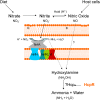HcpR of Porphyromonas gingivalis is required for growth under nitrosative stress and survival within host cells
- PMID: 22778102
- PMCID: PMC3418757
- DOI: 10.1128/IAI.00561-12
HcpR of Porphyromonas gingivalis is required for growth under nitrosative stress and survival within host cells
Abstract
Although the Gram-negative, anaerobic periodontopathogen Porphyromonas gingivalis must withstand nitrosative stress, which is particularly high in the oral cavity, the mechanisms allowing for protection against such stress are not known in this organism. In this study, microarray analysis of P. gingivalis transcriptional response to nitrite and nitric oxide showed drastic upregulation of the PG0893 gene coding for hybrid cluster protein (Hcp), which is a putative hydroxylamine reductase. Although regulation of hcp has been shown to be OxyR dependent in Escherichia coli, here we show that in P. gingivalis its expression is dependent on the Fnr-like regulator designated HcpR. Growth of the isogenic mutant V2807, containing an ermF-ermAM insertion within the hcpR (PG1053) gene, was significantly reduced in the presence of nitrite (P < 0.002) and nitric oxide-generating nitrosoglutathione (GSNO) (P < 0.001), compared to that of the wild-type W83 strain. Furthermore, the upregulation of PG0893 (hcp) was abrogated in V2807 exposed to nitrosative stress. In addition, recombinant HcpR bound DNA containing the hcp promoter sequence, and the binding was hemin dependent. Finally, V2807 was not able to survive with host cells, demonstrating that HcpR plays an important role in P. gingivalis virulence. This work gives insight into the molecular mechanisms of protection against nitrosative stress in P. gingivalis and shows that the regulatory mechanisms differ from those in E. coli.
Figures






Similar articles
-
The Porphyromonas gingivalis Hybrid Cluster Protein Hcp Is Required for Growth with Nitrite and Survival with Host Cells.Infect Immun. 2019 Mar 25;87(4):e00572-18. doi: 10.1128/IAI.00572-18. Print 2019 Apr. Infect Immun. 2019. PMID: 30670550 Free PMC article.
-
Nitric oxide stress resistance in Porphyromonas gingivalis is mediated by a putative hydroxylamine reductase.J Bacteriol. 2012 Mar;194(6):1582-92. doi: 10.1128/JB.06457-11. Epub 2012 Jan 13. J Bacteriol. 2012. PMID: 22247513 Free PMC article.
-
Nitrosative stress sensing in Porphyromonas gingivalis: structure of and heme binding by the transcriptional regulator HcpR.Acta Crystallogr D Struct Biol. 2019 Apr 1;75(Pt 4):437-450. doi: 10.1107/S205979831900264X. Epub 2019 Apr 5. Acta Crystallogr D Struct Biol. 2019. PMID: 30988260 Free PMC article.
-
Regulation of hemin and iron transport in Porphyromonas gingivalis.Adv Dent Res. 1995 Feb;9(1):41-7. doi: 10.1177/08959374950090010801. Adv Dent Res. 1995. PMID: 7669213 Review.
-
Iron and heme utilization in Porphyromonas gingivalis.FEMS Microbiol Rev. 2005 Jan;29(1):119-44. doi: 10.1016/j.femsre.2004.09.001. FEMS Microbiol Rev. 2005. PMID: 15652979 Review.
Cited by
-
Sequence and characterization of shuttle vectors for molecular cloning in Porphyromonas, Bacteroides and related bacteria.Mol Oral Microbiol. 2020 Aug;35(4):181-191. doi: 10.1111/omi.12304. Epub 2020 Jul 9. Mol Oral Microbiol. 2020. PMID: 32592236 Free PMC article.
-
Nitrite reductase is critical for Pseudomonas aeruginosa survival during co-infection with the oral commensal Streptococcus parasanguinis.Microbiology (Reading). 2016 Feb;162(2):376-383. doi: 10.1099/mic.0.000226. Epub 2015 Dec 15. Microbiology (Reading). 2016. PMID: 26673783 Free PMC article.
-
Phylogenomic analysis of the Porphyromonas gingivalis - Porphyromonas gulae duo: approaches to the origin of periodontitis.Front Microbiol. 2023 Jul 19;14:1226166. doi: 10.3389/fmicb.2023.1226166. eCollection 2023. Front Microbiol. 2023. PMID: 37538845 Free PMC article.
-
PgRsp Is a Novel Redox-Sensing Transcription Regulator Essential for Porphyromonas gingivalis Virulence.Microorganisms. 2019 Nov 28;7(12):623. doi: 10.3390/microorganisms7120623. Microorganisms. 2019. PMID: 31795139 Free PMC article.
-
S-nitrosoglutathione accelerates recovery from 5-fluorouracil-induced oral mucositis.PLoS One. 2014 Dec 5;9(12):e113378. doi: 10.1371/journal.pone.0113378. eCollection 2014. PLoS One. 2014. PMID: 25478918 Free PMC article.
References
-
- Allaker RP, Silva Mendez LS, Hardie JM, Benjamin N. 2001. Antimicrobial effect of acidified nitrite on periodontal bacteria. Oral Microbiol. Immunol. 16:253–256 - PubMed
-
- Aragao D, Mitchell EP, Frazao CF, Carrondo MA, Lindley PF. 2008. Structural and functional relationships in the hybrid cluster protein family: structure of the anaerobically purified hybrid cluster protein from Desulfovibrio vulgaris at 1.35 A resolution. Acta Crystallogr. D Biol. Crystallogr. 64:665–674 - PubMed
-
- Arnold K, Bordoli L, Kopp J, Schwede T. 2006. The SWISS-MODEL workspace: a web-based environment for protein structure homology modelling. Bioinformatics 22:195–201 - PubMed
-
- Beck JD, Offenbacher S, Williams R, Gibbs P, Garcia R. 1998. Periodontitis: a risk factor for coronary heart disease? Ann. Periodontol. 3:127–141 - PubMed
Publication types
MeSH terms
Substances
Grants and funding
LinkOut - more resources
Full Text Sources
Molecular Biology Databases
Miscellaneous

